Sensory Diet: Practical Ways to Incorporate Sensory Input
08.05.2018
This blog will focus on Sensory Processing Difficulties in Children, with an emphasis on the sensory systems, development of a “Sensory Diet” and practical ways to incorporate sensory input, evidence-based research on sensory diets, and the reveal of “Sensory Diet: The Complete Collection”.
Sensory Processing . . . What Does it Mean?
Sensory processing is what makes it possible for a child to use the sensory input he/she is receiving from their body and environment in a functional, adaptive manner. Effective sensory processing is necessary for almost every activity a child performs. We must be able to integrate the information we receive from all our senses to understand our surroundings successfully.
A child with sensory processing concerns has difficulty using sensory input from his/her eyes (vision), ears (sound), skin (touch), nose (smell), mouth (taste), muscles and body joints (body awareness), and inner ear (balance & position of body in space).
What are the Different Senses?
We will explore the Seven Different Sensory Systems: Visual, Auditory, Tactile, Olfactory, Gustatory, Proprioception, and Vestibular System.
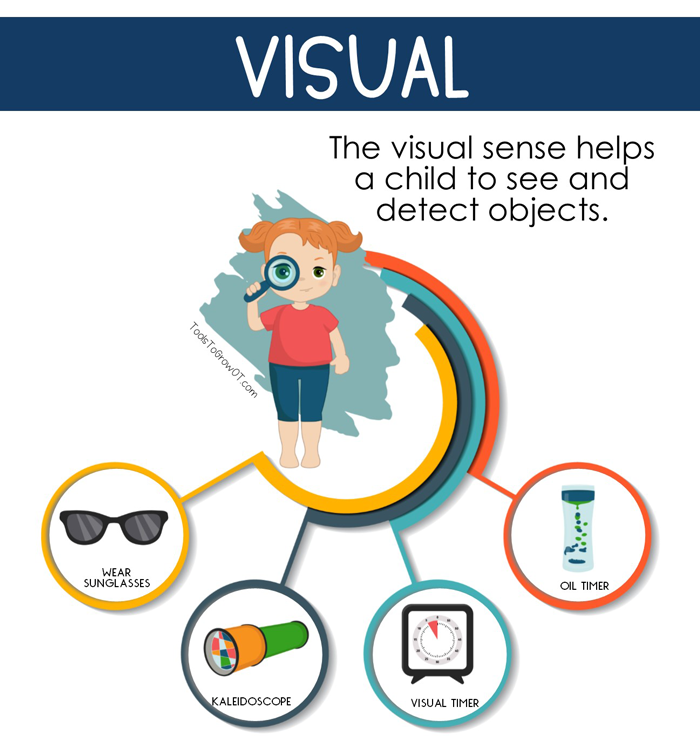
VISUAL:
The sense of vision uses the eyes to collect information, in which the brain then interprets. The visual system works closely with the other senses to help us safely navigate and locate objects in our environments.
Visual activities and input help children develop visual perception skills, engage in visual tracking, and improve visual attention and ocular-motor control. Difficulties with visual processing may significantly impact a child’s academic achievement.
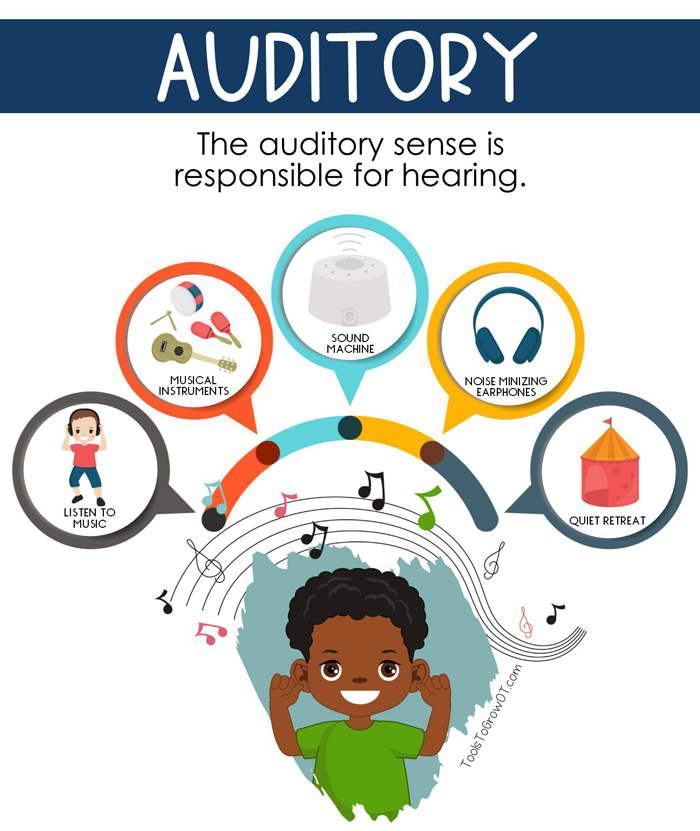
AUDITORY:
This sense helps a child detect the pitch, loudness, and tone of a noise or sound. This sense also allows us to take in the sounds we hear, process them, and create a correct response. It determines if a sound is dangerous and alerting or quiet and calm. This sense is important for listening skills, communication, and social skills.
Trouble with the auditory system can result in misunderstanding information or missing parts of sentences. It can also result in being overwhelmed or scared by certain sounds. When these sounds occur the child may cover their ears or duck their head. Other children may not hear the sounds around them which results in them always making sounds, humming, or singing.
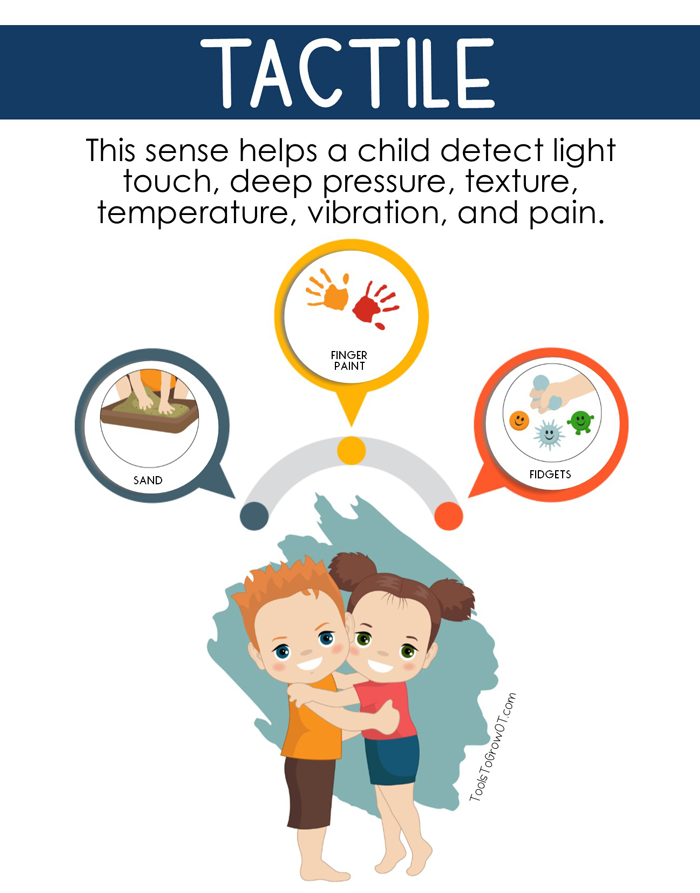
TACTILE:
This sense is detected through receptors in the skin. Information from this sense allows a child to feel when he/she is being touched and the quality of that touch. It also allows a child to determine what he/she is touching without the use of their vision.
Difficulty in tactile perception can have significant impact on a child’s emotional well-being. Intact tactile processing is important for develop body awareness, hand use skills, and motor planning.

OLFACTORY:
This sense helps us to differentiate between thousands of different odors and determine if they are dangerous, foul, pleasurable, strong, or faint. Sensory receptors in our nose pick up information about the odors around us and send the information to our brain. This system also help create the flavors we taste in food. Our sense of smell is also linked to our memories and can affect our mood. The sense of smelling is important for a baby’s bonding with their caregiver. This sense is also protective against toxins and other odor omitting substances.
Difficulty in processing olfactory information can result in children who crave smells and may not understand safe vs dangerous smells. Other children may gag or vomit from smells that most people don’t notice or consider unpleasant. Children with an aversion to smells may have trouble at meal times.
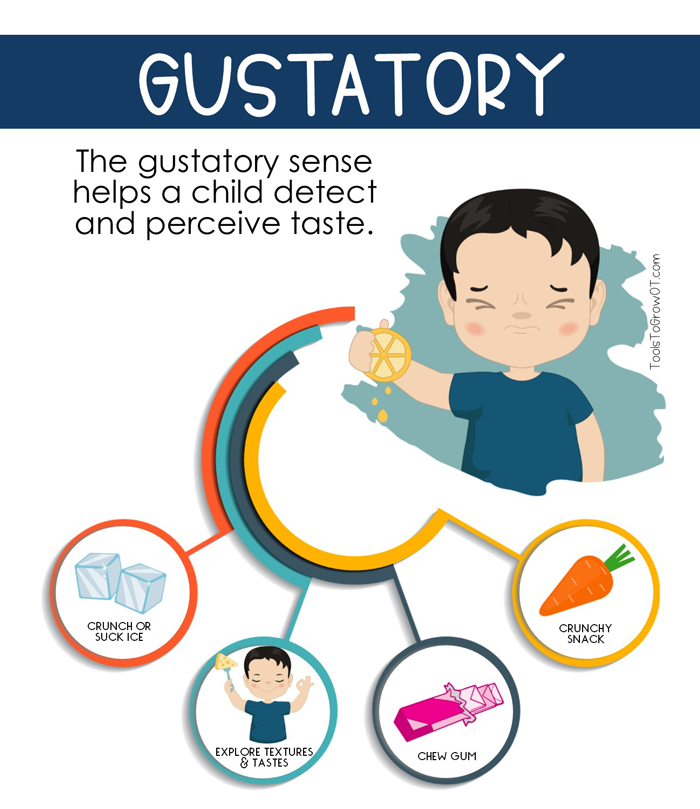
GUSTATORY:
It allows a child to discriminate between food flavors and tastes, such as sweet, sour, salty, bitter, and savory. Taste is received through taste buds and receptor cells on the tongue.
Difficulty in gustatory processing might cause your child to be a very picky eater or crave oral input, therefore demonstrating challenging behaviors during meal time. Gustatory activities and input help children to acquire eating and drinking habits as well as further categorize or identify foods based on their respective taste, texture, temperature or sense of smell.

PROPRIOCEPTION:
Intact proprioception allows a child to determine his/her body’s position in space and regulate the direction and amount of force to use when moving. This sense is detected through sensory receptors in the joints and muscles.
The proprioceptive sense is stimulated when a child experiences pressure or moves his/ her limbs to push, pull, lift or hang. While engaging in activities that offer proprioceptive input, a child may also show improved attention and a more regulated arousal level. This is beneficial for learning, playing, socializing, and completing daily tasks.
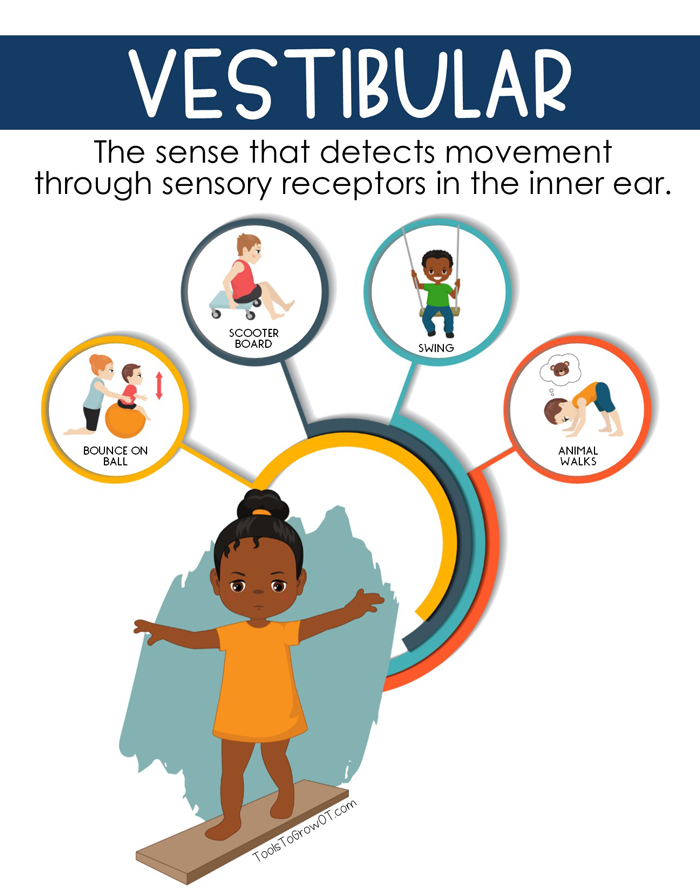
VESTIBULAR:
This sense tells a child when he/she is moving, and the direction and speed of that movement. Vestibular activities and input help children develop their posture, balance, and coordination. This sense provides us with gravitational security, the feeling that we can maintain a position without falling. When we move our head, fluid in our inner ear moves and shifts, providing information about the position of our body and head in space.
Difficulty with vestibular processing can result in a child who needs to move constantly to feel satisfied or a child who is fearful of movement because it makes them feel insecure or unbalanced. It can also result in difficulty coordinating and planning motor tasks.
How can OT Help?
One tool to help a child with sensory processing difficulties is the use of a “Sensory Diet”. This “diet” includes possible changes to your child’s environment as well as participation in meaningful sensory based activities. This “diet”, or “menu” of activities and strategies should be selected with a child’s interests and individual needs in mind.
A child’s therapist will help develop a “diet” that works for home and at school. Parents and teachers, you will play a key role in the development and delivery of the diet. The “diet” will be most beneficial for a child when it is provided at appropriate times of day and for an appropriate amount of time. The main goal will be to help a child function at his/her optimal level throughout their day with ideal attention, self-regulation, and emotional control.
Developing and Using a Sensory Diet
Just like every child is different, each child’s sensory diet will be different. The activities, accommodations and/or strategies that are selected from the “menu” will reflect your child’s profile, needs, and individual interests.
What Does Your Child’s OT Need from You?
It is very important to closely observe your child and take note of the following to help design a “diet” that is right for your child:
- Times of day that are especially challenging
- Response to transitions between settings and tasks
- Activities and routines that your child over-reacts to or avoids
- Activities that your child engages in for extended periods
- Preferred activities
- Challenging behaviors during meals or daily hygiene
- How your child reacts to clothing (fabric, sleeve length, etc.)
- How he/she reacts to food texture, tastes, smells, temperature, etc.
- Relationships with peers and adults
- Times when your child is especially active or inactive
Your child will change over time and in response to the use of the sensory diet activities, accommodations, and strategies.
What Strategies or Activities May Help?
Now that you know the basics of sensory processing, what a sensory diet is, and how occupational therapy can help, what are some of the sensory activities/strategies that could be incorporated into a sensory diet? It may take some time and trial and error to find the activities/strategies that work best for a specific child.
Proprioception: push/carry/pull heavy objects, wall pushups/chair pushups, climb on playground equipment, eat crunch food, animal walks, weighted blanket/vest, roll child in blanket (burrito rolling), crash pad
Vestibular: scooter board, swings, slides, spinning, rolling on the floor, bounce on ball, somersault, hang upside down from playground equipment, play “head, shoulders, knees, and toes”, cartwheels
Tactile: finger paint, sensory bins, skin massage, walk barefoot in sand, grass, or leaves, vibrating pen, kinetic sand, brushing protocol, joint compressions, sand tray, foam play, touch and feel books, water play
Gustatory: explore textures, tastes, and temperature of foods, chew gum, suck apple sauce or milkshake through a straw, flavored lip balms, lick or suck a lemon
Auditory: singing, blow whistles, listen to music, rain stick, listen to nature, sound machine, noise cancelling headphones, water fountain
Olfactory: use scented markers, smell essential oils, diffuser oil bracelet or necklace, scented bubbles, scratch and sniff sticker
Visual: kaleidoscope, glow sticks, lava lamps, fish tank, sensory bottles, mazes, dot-to-dot, light table, colored light bulbs, tinted lenses for indoors, “safe space” with minimal visuals, dim lights
What Does the Research Say?
For children who have sensory processing impairments, the classroom can be an overwhelming place. Evidence shows that incorporating sensory integration strategies into a child’s every day routine at school can be beneficial to their academic success. It is important to design a sensory diet to meet the unique needs and goals as well as the particular tolerance and interests of the child at the time (Case-Smith, & Bryan, 1999).
One study found success in balancing intervention activities that provided strong somato-vestibular input to help the child learn to motor plan and generalize new skills in and outside the classroom. Through the implementation of a sensory diet, children with sensory processing impairments are allowed ample opportunities to receive beneficial sensory input at frequent intervals, thereby enabling him or her to participate more fully in activities that comprise his or her daily schedule.
Along with direct therapeutic intervention, the implementation of an individualized sensory diet and environmental modifications that are tailored to the child’s unique sensory processing needs are important for success (Nackley, 2001, Baranek p. 407, 2002). Overall, this could be beneficial in a school setting due to the significant gains proven to be made in a child’s reading, math and written language (May-Benson, & Koomer, 2010). Lastly, along with improved academic achievement, seven studies have showed to produce positive outcomes, improvements in tactile discrimination, and decreases in sensory defensiveness with the integration of routine sensory strategies.
Within the school or classroom context it is important to involve the classroom teacher while developing a sensory diet, especially when choosing the specific sensory strategies. Overall, through the use of sensory diets, a child can maintain the ability to organize his/her behavior, improve attention, and development and engage in age appropriate peer relationships through the participation in games and sports.
While a majority of the research on sensory diets and sensory integration therapies are focused on use in the school or clinical setting, it is important to look at the home setting as well. As stated above, functioning in school for children with sensory processing impairments can be extremely difficult and overwhelming. Research shows that children reactions to overwhelming sensory experiences are similar at home and at school. Brown and Dunn (2010) conducted a study to look at the relationship between context and sensory processing in children with Autism. They found that sensory processing patterns have universal qualities as well as context-specific qualities (Brown and Dunn, 2010). This simply shows that a sensory diet or sensory strategies should be implemented in both the school and home but the specific strategies used for each setting will differ based on the unique sensory qualities of each environment.
Wild & Jones, 2010) found that in 26 out of the 29 cases studied there were positive changes in the target behavior being addressed by the diet. 71% of parents also stated that they noticed other positive changes in their child that could be attributed to the sensory diet. The study shows that sensory diets can have a positive effect on emotional over-responsiveness, resistance to ADLs, sleep issues, impulsivity, and pressure-seeking behaviors (Wild and Jones, 2010). Another study found that sensory diets combined with therapeutic listening were effective in improving behaviors associated with sensory processing difficulties (Hall and Case-Smith, 2007).
When planning a sensory diet to be used in the home setting, it is extremely important to include the parents/caregivers in the planning of the sensory diet to ensure that the diet best matches the family’s needs as well as the child’s needs. Cohn et al. (2000), found that parents feel that when they are involved in the therapy planning they are able to better understand their children’s behaviors which helps them to better support their child. Cohn et al. (2000) also stated “to be effective, intervention must be sustainable within the contexts of family life” (p. 42).
Sensory Diet: The Complete Collection
Everything You Need for Developing and Implementing a Sensory Diet
Tools to Grow is very excited to reveal our “Sensory Diet: The Complete Collection". No need to look further! We have everything you will need to learn about, educate others, develop, and implement a SENSORY DIET!
Sensory Diet: The Complete Collection includes everything you need when developing and implementing a Sensory diet for a child.
Customize the PDF by typing directly into the file to customize and create a sensory diet. Follow the detailed instructions and therapist tips to create a personalized Sensory Diet binder for the child/student.
There are 2 different Versions:
- Sensory Diet- Complete Collection: Home Version
- Sensory Diet- Complete Collection: School Version
The following resources are included in each Complete Collection:
Background information/Guidelines: This is a one page review of Sensory Processing and the use of a sensory diet.
Therapist Tips: How to Create Sensory Diet: This two page Tips Sheet reviews important information to obtain in order to determine a child’s needs and strengths in sensory processing. Tips therapists should follow and guidelines to provide to parents/teachers when developing and implementing a Sensory Diet.
Assembly Instructions: Detailed instructions for printing and assembling a Sensory Diet binder.
Editable title page: Customize the Sensory Diet for the child by typing directly into PDF. The therapist can type the child’s name, Therapist Name, Therapist Title, and Therapist contact information.
Information Sheet & Instructions for Parents/Teachers: This is a three page handout for Parents/Teachers to include in your Sensory Diet binder. Includes education on Sensory Processing and guidelines for collecting information and developing a sensory diet.
Includes detailed instructions for parents/teachers to follow when implementing and carrying out a child’s Sensory Diet.
Editable Sensory Diet Charts: This is a 6-page Editable Chart of specified Time Frames/Daily Routine Categories. In each Category, there is an option to TYPE directly into PDF specific and personalized instructions.
- Home Use Categories: Transitions, Quiet Time, Snacks/Mealtime, Community Outings, Play & Leisure, Dressing, Bathing, Grooming, Toileting, Bedtime/Sleep, Homework, Family Events, Doctor Visits, and Car Rides. Also includes option to enter your own individualized Time Frame/Routine Category.
- School Use Categories: Transitions, Desk Work, Snacks/Mealtime, Recess/Free Time, Cafeteria, Special Classes, Bus Ride, Mobility: Hall/Classroom, Assemblies, Community Outings, Carpet Time, Free Play, Independent Work, and Centers. Also includes option to enter your own individualized Time Frame/Routine Category.
.png)
Picture symbols: There is an option to select 2-3 picture symbols for each time frame/daily routine. These picture symbols depict practical ideas to enrich or alter a child’s sensory environment. Includes 92 Picture symbols. These symbols depict Proprioception, Gustatory, Auditory, Olfactory, Tactile, Vestibular, and Visual Sensory input.
Protocol for Parent/Teacher Use: This Editable PDF is exactly what you need if you are recommending a sensory diet. TYPE directly into Protocol Use form to enter child's information.
Tracking Form: A great and efficient way to track and monitor a child's Sensory Diet.
Additional NEW Sensory Diet Resources:
Sensory Processing: Basic Information Guide: FREE PRINTABLE!
This 5 Page PDF is the perfect handout for Parents, Families, Teachers, etc.
Includes (1) What is Sensory Integration Disorder and Treatment? (2) The Sensory Systems, and (3) Terms and Definitions related to Sensory Integration.
Red Flags: Includes 5 Printable “Red Flags” of Sensory Processing Disorder in Children. Topics Include:
- Sensory Over Responsivity Red Flags
- Sensory Under Responsivity Red Flags
- Sensory Seeking Red Flags
- Sensory Based Motor Disorder Red Flags
- Sensory Discrimination Red Flags

Sensory Systems: Ideas & Activities: This 8 Page PDF is the perfect handout for Parents, Families, Teachers, etc. Describes the Sensory Systems and lists sensory strategies, activities, and practical ways to incorporate sensory input. This handout is the perfect tool!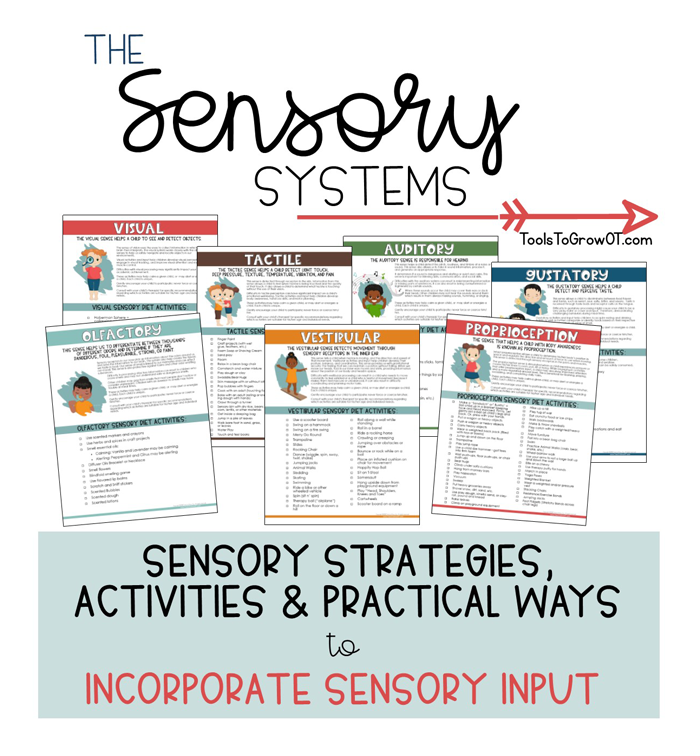
Parent/Caregiver Information Sheet: This is a three page handout for Parents/Caregivers to include in your Sensory Diet binder. Includes education on Sensory Processing and guidelines for collecting information and developing a sensory diet.
Teacher/Educator Information Sheet: This is a three page handout for Teachers/Educators to include in your Sensory Diet binder. Includes education on Sensory Processing and guidelines for collecting information and developing a sensory diet.
Calm Down Cards: This PDF includes 55 high quality cards! Personalize by typing directly into PDF students name.

We hope these Sensory Diet & Sensory Processing specialized resources will provide you with the tools necessary to help with the most important job there is … helping children grow!

Find all SENSORY DIET RESOURCES HERE!
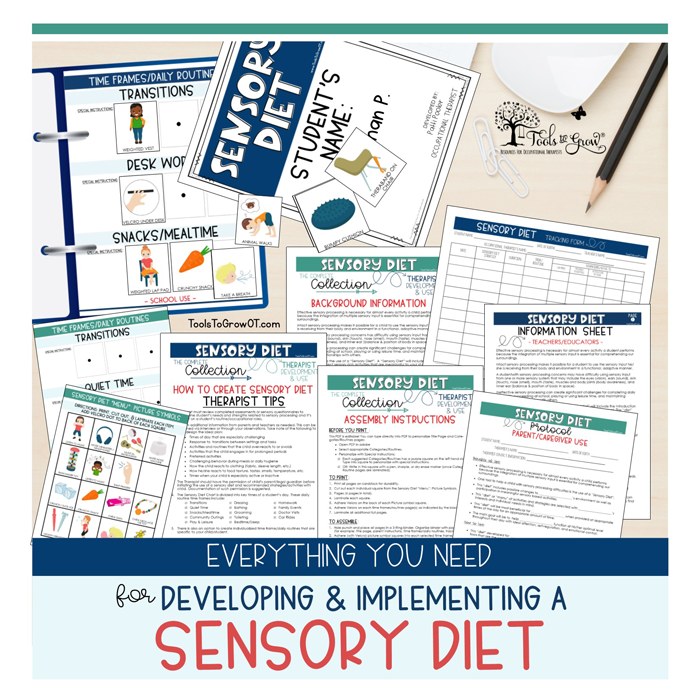
THANK YOU!
Tools to Grow would like to thank our 2018 Community Practice Occupational Therapy Students, Courtney Adamczak and Elizabeth Lyons for their contribution and assistance in writing this blog post. Courtney and Elizabeth are both recent graduates of Occupational Therapy from D’Youville College in Buffalo, New York. We were so appreciative for your time and dedication to our students and the Occupational Therapy profession!
REFERENCES
Baranek, T. G. (2002). Efficacy of sensory and motor intervention for children with autism.
Journal of Autism and Developmental Disorders, 32, 397-421.
Brown, N. B., & Dunn, W. (2010). Relationship between context and sensory processing in children with Autism. American Journal of Occupational Therapy, 64, 474-483. doi: 10.5014/ajot.2010.09077
Case-Smith, J., & Bryan, T. (1999). The effects of occupational therapy with sensory integration emphasis on preschool-age children with autism. American Journal of Occupational Therapy, 53, 489-497.
Cohn, E., Miller, L. J., & Tickle-Degnen, L. (2000). Parental hopes for therapy outcomes: Children with sensory modulation disorders. American Journal of Occupational Therapy, 54, 36-43. doi: 10-5014/ajot.54.1.36
Hall, L., & Case-Smith, J. (2007). The effect of sound-based intervention on children with sensory processing disorders and visual-motor delays. American Journal of Occupational Therapy, 61, 209-215.
May-Benson, T. A, & Koomer, J. A. (2010). Systematic review of the research evidence examining the effectiveness of interventions using a sensory integrative approach for children. American Journal of Occupational Therapy, 64, 403-414. doi: 10.5014/ajot.2010.09071
Nackley, L. V. (2001). Sensory diet applications and environmental modifications: a winning combination. American Occupational Therapy Association Inc, 24.
Wild, G., & Jones, L. D. (2010). Parents’ perception of effectiveness of sensory diets for children: A multiple case study analysis.
Related Topics: Free Resources , Press Releases, Sensory Processing/Self-Regulation, Tools to Grow at Home , Tools to Grow at School


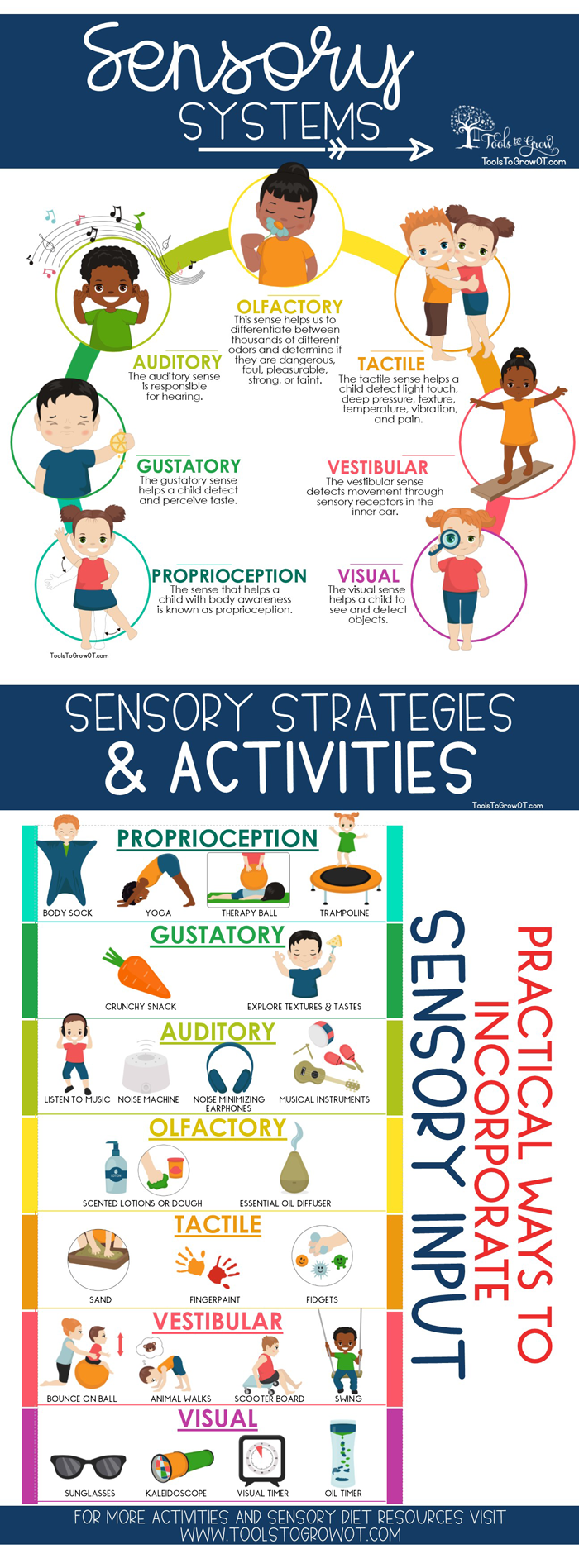
.png)
